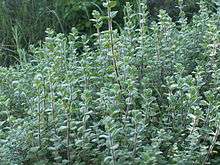Origanum syriacum
Origanum syriacum; syn. Majorana syriaca (also Origanum maru, although this primarily refers to a hybrid of O. syriacum),[3] bible hyssop,[4] Biblical-hyssop,[1] Lebanese oregano[1] or Syrian oregano,[1] is an aromatic perennial herb in the mint family, Lamiaceae.
| Origanum syriacum | |
|---|---|
 | |
| Scientific classification | |
| Kingdom: | Plantae |
| Clade: | Tracheophytes |
| Clade: | Angiosperms |
| Clade: | Eudicots |
| Clade: | Asterids |
| Order: | Lamiales |
| Family: | Lamiaceae |
| Genus: | Origanum |
| Species: | O. syriacum |
| Binomial name | |
| Origanum syriacum | |
| Synonyms[2] | |
|
Majorana syriaca (L.) Raf. | |
Etymology
The plant may be called za'atar by association with its use in an herb-spice mixture. In Modern Hebrew, it is called ezov, and it may have been the ezob of Classical Hebrew.[5] In many English translations of the Bible, ezov is rendered as hyssop, hence the common name for bible hyssop, believed to be a different plant generally identified with Hyssopus officinalis. The problems with identification arise from Jewish oral tradition where it expressly prohibits Greek hyssop, and where the biblical plant is said to have been identical to the Arabic word, zaatar (Origanum syriacum), and which word is not to be associated with other ezobs that often bear an additional epithet, such as zaatar farsi = Persian-hyssop (Thymbra capitata) and zaatar rumi = Roman-hyssop (Satureja thymbra) and zaatar mani = Calamint (Calamintha incana).[6]
Description
.jpg)
Origanum syriacum grows to a height of 1 meter. The plant is pollinated by bees.[4] Flowers are small and white or pale pink.[7]
Distribution
Origanum syriacum is native to the Middle East.[1] In Egypt, Origanum syriacum subsp. sinaicum is a very rare plant that grows on stony ground in Sinai Peninsula including the coastal Mediterranean strip.[8] From the conservation point of view it is an endangered plant.
Use
It is a preferred primary ingredient in the spice mixture za'atar. So precious is this herb that in the Levant, Arabs will send out foraging parties to gather it. Origanum syriacum is harvested in the wild for use in preparing za'atar, a mixture of dried herbs, sesame and sumac for flavoring and garnish. However, it has recently entered cultivation due to high levels of demand.[9]
References
- "Origanum syriacum". Germplasm Resources Information Network (GRIN). Agricultural Research Service (ARS), United States Department of Agriculture (USDA). Retrieved 22 April 2013.
- "Origanum syriacum L.". World Checklist of Selected Plant Families (WCSP). Royal Botanic Gardens, Kew. Retrieved 21 April 2013 – via The Plant List.
- "Za'atar, a renowned herb blend, and events inspired by it". Vegetable Gardener. 29 September 2010.
- "Origanum syriacum Bible Hyssop". PFAF Plant Database. Plants For A Future. Retrieved 21 April 2013.
- Based on the Judeo-Arabic translation of the word in the works of Rabbi Saadia Gaon (in his Tafsir, a translation of the Pentateuch, Exo. 12:22), Nathan ben Abraham I in Mishnah Uktzin 2:2, Rabbi Jonah ibn Janah (Sefer HaShorashim - Book of the Roots, s.v. אזב - aleph, zayn, bet), and Maimonides (in his Mishnah Commentary, Nega'im 14:6).
- The Mishnah (ed. Herbert Danby), Oxford University Press: Oxford 1977, s.v. Negai'im 14:6 (p. 696); Parah 11:7 (p. 711).
- "Origanum syriacum". Missouri Botanical Garden. Retrieved 21 April 2013.
- Boulos, Loutfy (2002). Flora of Egypt. Volume 3: Verbenaceae-Compositae. Cairo, Egypt: Al-Hadara Publishing. p. 12. ISBN 9775429250.
- Khairallah, Simon (1 January 2010). "Plant story - helping to conserve Origanum syriacum". Kew News. Kew Royal Botanic Gardens. Retrieved 21 April 2013.
External links

